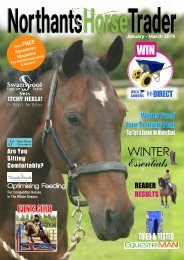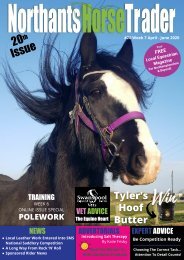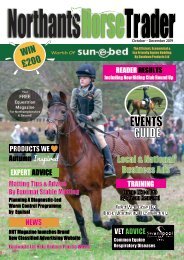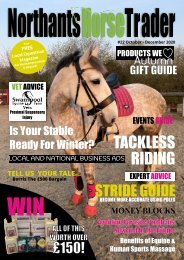NHT Magazine Summer 2019
You also want an ePaper? Increase the reach of your titles
YUMPU automatically turns print PDFs into web optimized ePapers that Google loves.
FEATURE<br />
Riding For Everyone!<br />
The term ‘classical’ riding is often much<br />
misunderstood. Firstly, many people think of it as<br />
elitist or consisting of advanced or difficult<br />
dressage. The word classical actually means that<br />
it has its origins in past centuries and has passed<br />
the test of time. Although there are slight<br />
differences of opinion in the classical world, its<br />
principles have, and always will, remain the same<br />
to any true classicist. This is because it is based<br />
on the laws of nature, such as gravity, and the<br />
natural biomechanics of the horse. Although<br />
horses are bred differently for different purposes,<br />
their basic make-up and way of movement has<br />
remained the same for thousands of years.<br />
The word dressage means to ‘dress’ or prepare<br />
the horse for whatever work it is intended, and<br />
all dressage has its origins in classical<br />
horsemanship. Therefore, all horses, from big<br />
Warmbloods down to Shetland ponies should be<br />
prepared for their work by basic dressage.<br />
Whatever you intend to do with your horse he will<br />
benefit from basic classical dressage, and<br />
classical merely means ‘correct’ in this sense.<br />
FEI Rules Are Based On Classical<br />
Principles<br />
Also, those who have been brought<br />
on too quickly, at an early age, or<br />
pulled in from the front end into<br />
rollkur or hyperflexion very often<br />
suffer physical break down at an<br />
early age.<br />
For All Disciplines<br />
Whatever your chosen discipline, a<br />
basic grounding in classical<br />
dressage will greatly benefit your<br />
horse. Added to this he will be a<br />
much more pleasant ride, being<br />
lighter in the forehand, easier to<br />
turn, more agile and a safer ride.<br />
Riding with an independent classical<br />
seat is very much safer and better<br />
balanced than using say a ‘chair’<br />
seat, as frequently seen.<br />
A chair seat is when the rider’s seat is at the back<br />
of the saddle, putting too much weight on the<br />
weakest part of the horse’s back and<br />
making the rider most unstable<br />
and likely to go ‘out the side<br />
door’ at the slightest<br />
spook.<br />
A Chair Seat<br />
Courtesy of Black Tent Photograph<br />
The FEI Rule Book is based firmly upon the<br />
principles set down by Francois Robichon de la<br />
Gueriniere, one of the most revered Classical<br />
Masters. If all these rules were adhered to, then<br />
all competitive dressage would be classical.<br />
Unfortunately, many judges have deviated from<br />
their own rule book and reward some bad<br />
practices, but thankfully not all; there are still<br />
some good judges who stick to classical<br />
principles.<br />
The Purpose Of Dressage<br />
Dressage is designed to physically and mentally<br />
prepare the horse to carry the rider with the<br />
optimum amount of ease, in the best-balanced<br />
way. All the exercises are designed to build up<br />
strength and flexibility in the back, joints and<br />
tendons; especially strengthening the hind legs,<br />
so that the horse can take more weight on the<br />
hindquarters, relieving the front legs of the extra<br />
pressure which they necessarily are burdened<br />
with, once a rider is aboard. All these exercises<br />
need to be done carefully, and strength built up<br />
slowly, so that the horse comes to a naturally<br />
more ‘round’ frame, which emanates from<br />
strength in the hindquarters. Hence the phrase<br />
‘the horse should be ridden from back to front’ –<br />
never pulled into an outline from the front.<br />
Horses naturally carry more weight on the<br />
forehand, but when the weight of the rider is<br />
added this causes undue strain on the forelegs<br />
and is one of the main causes of arthritic, tendon,<br />
etc. breakdown as the horse ages. A horse<br />
carefully prepared in the classical way has a<br />
much healthier and longer life expectancy than<br />
his counterparts who have been allowed to slop<br />
along on the forehand for most of their lives.<br />
The classical seat<br />
is not just for<br />
dressage. It can<br />
easily be<br />
adapted for<br />
jumping and<br />
cross country<br />
by shortening<br />
the stirrups a<br />
little, making it<br />
easier for the<br />
rider to follow<br />
the centre of<br />
gravity forward<br />
by folding from the<br />
hips, and lifting the<br />
seat slightly off the<br />
saddle. All the other<br />
laws of gravity remain the<br />
same. The weight aids for<br />
turning and re-aligning the horse<br />
before a jump render the horse much<br />
better balanced and more manoeuvrable,<br />
rather than relying on hauling on the reins as is<br />
so often seen.<br />
If you are a happy hacker, you will find classical<br />
training a real boon to your enjoyment. Your<br />
horse will be lighter, easier to turn, you will feel<br />
much more in control without any harsh aids.<br />
Your horse will be better at negotiating turns and<br />
uneven ground, and is likely to stay sound and<br />
live much longer if he is capable of taking some<br />
of the weight onto the haunches. Your seat will<br />
be much deeper and both you and your horse<br />
will be safer.<br />
The Classical Seat<br />
Weight Aids From The Beginning<br />
It is a source of sadness to me that the simple<br />
weight aids are not very often taught to new riders<br />
at riding schools these days. They are not difficult<br />
for the rider and are a natural thing for the horse<br />
to respond to, and very much more comfortable.<br />
For instance, to turn left the rider should put a<br />
little weight on the left stirrup, turn the head and<br />
shoulders to the left, giving just a gentle feel on<br />
the left rein, supported by the outside (right) leg<br />
taken very slightly back and the right rein being<br />
held in position to support the horse’s right<br />
shoulder. In this way the horse can make a very<br />
Photo Credit: by Black Tent Photography'<br />
29 NorthantsHorseTrader <strong>Magazine</strong> Feature enquiries: features@nhtmagazine.co.uk















